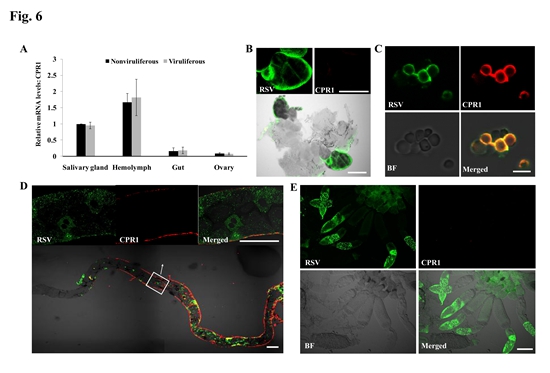分享到
Proteomic analysis of interaction between a plant virus and its vector insect reveal new functions of hemipteran cuticular protein
Numerous viruses can be transmitted by their corresponding vector insects; however, the molecular mechanisms enabling virus transmission by vector insects have been poorly understood, especially the identity of vector components interacting with the virus. Recently, researchers at State Key Laboratory for Biology of Plant Diseases and Insect Pests, Institute of Plant Protection (IPP) of CAAS have published a research paper on Molecular & Cellular Proteomics about new functions of hemipteran cuticular protein on virus transmission.

Expression of CPR1 and colocalization of RSV RNPs and CPR1 in different tissues of Laodelphax striatellus

Expression of CPR1 and colocalization of RSV RNPs and CPR1 in different tissues of Laodelphax striatellus
They used firstly the yeast two-hybrid system to study proteomic interactions of a plant virus (Rice stripe virus, RSV, genus Tenuivirus) with its vector insect, small brown planthopper (Laodelphax striatellus). Sixty-six proteins of L. striatellus that interacted with the nucleocapsid protein (pc3) of RSV were identified. Of the 66 proteins, five (atlasin, a novel cuticular protein, jagunal, NAC domain protein, and vitellogenin) were most likely to be involved in viral movement, replication and transovarial transmission. Secondly, they also provides evidence that the novel cuticular protein, CPR1, from L. striatellus is essential for RSV transmission by its vector insect. CPR1 binds the nucleocapsid protein (pc3) of RSV both in vivo and in vitro and colocalizes with RSV in the hemocytes of L. striatellus. Knockdown of CPR1 transcription using RNA interference resulted in a decrease in the concentration of RSV in the hemolymph, salivary glands and in viral transmission efficiency. These data suggest that CPR1 binds RSV in the insect and stabilizes the viral concentration in the hemolymph, perhaps to protect the virus or to help move the virus to the salivary tissues. This study provided direct experimental evidence that viruses could use existing vector proteins to aid their survival in the hemolymph. Identifying these putative vector molecules should lead to a better understanding of the interactions between viruses and vector insects.
More details are available on the bellow links:
http://www.mcponline.org/content/14/8/2229.full
More details are available on the bellow links:
http://www.mcponline.org/content/14/8/2229.full
Latest News
-
 Apr 18, 2024Opening Ceremony of the Training Workshop on Wheat Head Scab Resistance Breeding and Pest Control in Africa Held in CAAS
Apr 18, 2024Opening Ceremony of the Training Workshop on Wheat Head Scab Resistance Breeding and Pest Control in Africa Held in CAAS -
 Apr 03, 2024IPPCAAS Co-organized the Training Workshop on Management and Application of Biopesticides in Nepal
Apr 03, 2024IPPCAAS Co-organized the Training Workshop on Management and Application of Biopesticides in Nepal -
 Mar 28, 2024Delegation from the School of Agriculture and Food Science of University College Dublin, Ireland Visit to IAS, CAAS
Mar 28, 2024Delegation from the School of Agriculture and Food Science of University College Dublin, Ireland Visit to IAS, CAAS -
 Mar 25, 2024Director of World Food Prize Foundation visited GSCAAS
Mar 25, 2024Director of World Food Prize Foundation visited GSCAAS -
 Mar 20, 2024Institute of Crop Sciences (ICS) and Syngenta Group Global Seeds Advance Collaborative Research in the Seed Industry
Mar 20, 2024Institute of Crop Sciences (ICS) and Syngenta Group Global Seeds Advance Collaborative Research in the Seed Industry
